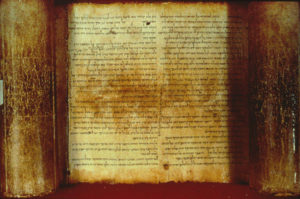Pesher Isaiah, Lawrence H. Schiffman, Reclaiming the Dead Sea Scrolls, Jewish Publication Society, Philadelphia 1994.
Six different manuscripts preserve fragments of a pesher on Isaiah. We cannot be certain whether these manuscripts represent parts of the same text or whether there was more than one composition dealing with this book, which was so seminal for the sect and its ideology. We have evidence of the special significance of this book for the sect in that twenty-two manuscripts of it were found among the documents. On the other hand, it may simply be coincidental that one complete scroll of this book and a second very substantial portion of a scroll survive.
Pesher Isaiah A deals with parts of Isaiah 10 and 11, interpreting the march of the Assyrians as referring to contemporary events and apparently referring to the invasion of Judaea by Seleucid Syria during the reign of Alexander Janneus (104–76 B.C.E.) This text, however, has recently become more important because it contains a parallel to the so-called pierced messiah text, actually called the War Rule, which, as will be shown in a later chapter, in reality has nothing at all to do with an executed or crucified messiah. It does, however, mention the sectarian leader termed Prince of the Congregation, who is expected to lead the sect into the End of Days, and the defeat of the Kittim, the enemies of the sect. This text is important for our discussion of the messianic idea in the scrolls. It should be noted here that the text refers only to one messiah, a “shoot of the branch of David,” not sharing the two-messiah concept, priestly and lay, found in some other Qumran and Second Temple documents.
Pesher Isaiah B, probably copied in the immediate pre-Herodian period, survives only for parts of chapter 5 of Isaiah. The sect’s opponents in this text are termed “the scoffers in Jerusalem,” who may be the followers of the Wicked Priest.
Pesher Isaiah C is dated paleographically to the early first century B.C.E. and may therefore be the earliest extant copy of a pesher text. As preserved, it includes comments on portions of Isaiah 8, 10, 14, 19, and 29–32, also quoting other prophets, namely Zechariah and Hosea. In that respect it differs from the other continuous pesharim. It may, in fact, have dealt only with parts of Isaiah. The text refers to the sect’s enemies, the “seekers of smooth things,” generally accepted as denoting the Pharisees, with whom the sect disagreed on matters of law and biblical interpretation, not to mention politics.
The fourth Isaiah pesher from cave 4, Pesher Isaiah D, composed in the early Hasmonaean period, is preserved in a copy from early Herodian times. It is extant only for Isaiah 54-11–12. It applies Isaiah’s vision of a New Jerusalem to the sect, interpreting the precious stones mentioned there to refer to different groups within the sect. The text refers to a group of twelve, either priests or Israelites, that governs the sect or the eschatological community. Attempts have been made to draw parallels from this text to the twelve apostles of early Christianity.
Pages 229-230




